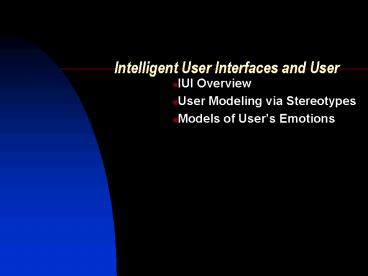Intelligent User Interfaces and User - PowerPoint PPT Presentation
1 / 32
Title:
Intelligent User Interfaces and User
Description:
AI's Application to UIs. What's Not Mentioned? Affect. of course. IUI's Roots. Turing Test ... Electronic Transactions on AI. http://www.dfki.de ... – PowerPoint PPT presentation
Number of Views:309
Avg rating:3.0/5.0
Title: Intelligent User Interfaces and User
1
Intelligent User Interfaces and User
- IUI Overview
- User Modeling via Stereotypes
- Models of Users Emotions
2
Intelligent User Interfaces An Introduction
3
Two Major Areas of Discussion
- Introduction to Intelligent User Interfaces
(IUI) - Overview of the collection of readings contained
in Readings in Intelligent User Interfaces
4
Motivation
- WIMP (windows, icons, menus, and pointing) now
standard for most apps - IUIs will provide adaptivity, context
sensitivity, and task assistance - IUIs should be learnable, usable, and transparent
5
Definition
- Intelligent User Interfaces are human-machine
interfaces that aim to improve the effiency,
effectiveness, and naturalness of human-machine
interaction by representing, reasoning, and
acting on models of the user, domain, task,
discourse, and media.
6
Definitions
- Mode or Modality refers primarily to the human
senses vision, audition, olfaction, touch, and
taste. - Medium refers to the material object used for
presenting or saving information (I/O devices) - Code refers to a system of symbols (natural
language, pictorial language, gestural language)
7
Relationship Between Medium, Mode, and Code
8
Whats Not Mentioned?
- Human mediums
- eyes, ears, skin, etc.
9
IUI Architecture
10
Current Interface Pratice Related to IUI
11
No Generation w/o Representation
- Various constiuents of multimodal
communication should be generated on the fly from
a common representation of what is to be conveyed
w/o using any preplanned text or images.
12
AIs Application to UIs
13
Whats Not Mentioned?
- Affect
- of course
14
IUIs Roots
- Turing Test
- Pattern matching from a conversational database
- Intelligent Tutoring
- Automated Interface Design
- Natural Language Interfaces
- Standard Reference Model (SRM) for Intelligent
Multimodal Presentation Systems (IMMPS) - Email Filters
- Bayesian-based user models
15
Major Topics Covered by Readings
- Analysis of Input
- Generation of Output
- User and Discourse Models
- Model-Based Interfaces
- Agent-Based Interaction
- Empirical Evaluation
16
Resources
- http//www.mitre.org/resources/centers/it/maybury/
iui99/sld001.htm - Intelligent User Interfaces An Introduction
- http//cslu.cse.ogi.edu/HLTsurvey/
- Survey of the State of the Art in Human Language
Technology (1996) - http//search.nap.edu/readingroom/books/screen/
- More Than Screen Deep Toward Every-Citizen
Interfaces to the Nation's - Information Infrastructure
17
Resources
- http//degraaff.org/hci/
- HCI Index (news and a list of references)
- http//www.etaij.org/
- Electronic Transactions on AI
- http//www.dfki.de/
- The German Research Center for Artificial
Intelligence - http//www.dfki.de/sigmedia/
- Multi-Language Processing
- http//www.i3net.org/
- European Network for Intelligent Information
Interfaces
18
User Modeling via Stereotypes
- Elaine Rich
- University of Texas
19
Why User Modeling?
- People need to form a model of the person with
whom they are dealing before they can behave
properly. - Examples
- PS2 Controller size, Auto Insurance Quote
20
User Modeling via Stereotypes
- A stereotype is a cluster of characteristics
- e.g.
- Profession Stereotype
- income level, dress code at work, degree, etc
- Ethnic group stereotype
- Food preference, spacial distance
21
Stereotypes Are Based on Domain
- Entertainment Industry
- caremovie, music preference, education level
- dont dress, weight, height
- Car Sales Industry
- care income, family size
- dont education level, religion
22
Stereotypes Are Based on Probability
- How confident are we ?
- Computer Science Professor - NON_TV 85
- College Graduates - over 20 90
- Probability may result in unfairness.
23
So, a Stereotype is a set of triples
- (Attribute, Value, Rating)
- Medical Doctor
- (Income, 4, 900)
- (Education, 5, 900)
- (Afraid-of-Blood, -5, 900)
- (Watch-TV, -3, 800)
24
A Stereotype Contains Triggers
- A trigger is a hint that instantiate other
stereotypes. - Medical Doctor
- High_Education_Trigger -gt NonTV_StereoType
- High_Income_Trigger -gt House_Owner
- A trigger also has rating as confidence level.
25
Over View of Grundy the Librarian
- Has pre-built stereotypes
- Hierarchical memory
- Global, individual, dialogue
- Algorithm for activating stereotypes
- Adaptation of stereotypes
26
Activating Stereotypes (by triggers)
- If trigger already instantiated, do nothing, if
not, instantiate it. - Example
- Name John - Man_trigger (instantiate)
- Father - Man_trigger (ignore)
27
Activating Stereotypes (by triggers)
- If stereotype has not been activated before, it
is activated now. - Name John -gt Man_trigger -gt Man_stereotype
- If stereotype has been activated before and still
active (confirmation) - Father -gt Man_trigger_Rating up -gt
Man_Stereotype_Rating up
28
Activating Stereotypes (by triggers)
- If stereotype has been activated before, but its
not activated now. The situation must be
re-examined on the basis of the balance of the
evidence is in favor or opposed to the
stereotype. - How to calculate the balance of evidence???
- Whats the definition of in favor or oppose
?
29
Adaptation of stereotypes
- Why?
- Lack of real data at construction time results
in the need of adaptation of stereotypes. - Concern
- Prevent bias because of frequent usage by a few
users, need weighted constant of the overall
values.
30
Adaptation of stereotypes
- Confirmation Case
- increase VALUE
- increase RATING
- M.D. -gt (Income, 3, 800)
- Drive Ferrari -gt (Income, 4, 900)
- New_Value (3 100 4) / (100 1) 3.01 gt 3
- New_Rating 800 900/800 801.125 gt 800
31
Adaptation of Stereotypes
- Conflict case
- decrease VALUE
- decrease RATING
- M.D. -gt (Non_TV_Person, 4, 800)
- Subscribe to TV_Guide -gt (Non_TV_Person, -5,
900) - New_Value (4 100 - 5) / (100 1) 3.91 lt 4
- New_Rating 800 - 900/800 799.875 lt 800
32
Results of Grundy
Controlled Random
GOOD 102 54
BAD 39 60

